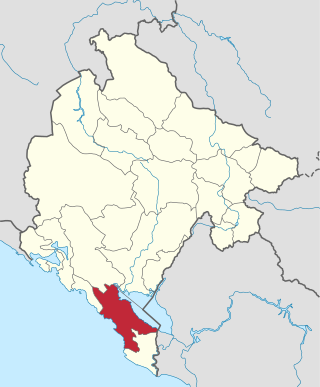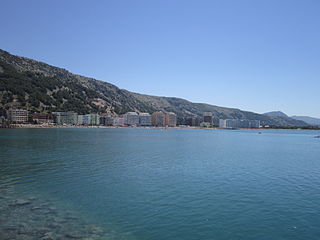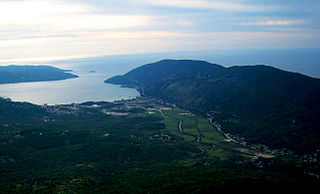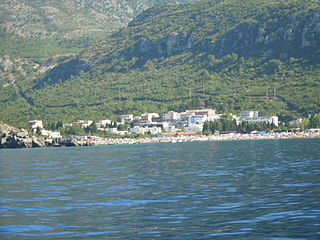
Bar is a coastal town and seaport in southern Montenegro. It is the capital of the Bar Municipality and a center for tourism. According to the 2011 census, the city proper had 13,503 inhabitants, while the total population of Bar Municipality was 42,068.

Budva is a Montenegrin town on the Adriatic Sea. It has 19,218 inhabitants, and it is the centre of Budva Municipality. The coastal area around Budva, called the Budva Riviera, is the center of Montenegrin tourism, known for its well-preserved medieval walled city, sandy beaches and diverse nightlife. Budva is 2,500 years old, which makes it one of the oldest settlements on the Adriatic coast.

Sveti Stefan is a town in Budva Municipality, on the Adriatic coast of Montenegro, approximately 6 kilometres (3.7 mi) southeast of Budva. The town is known for the Aman Sveti Stefan resort, a 5-star franchise of the international group of Aman Resorts.

Ulcinj is a town on the southern coast of Montenegro and the capital of Ulcinj Municipality. It has an urban population of 10,707 (2011), the majority being Albanians.

Makarska is a town on the Adriatic coastline of Croatia, about 60 km (37 mi) southeast of Split and 140 km (87 mi) northwest of Dubrovnik, in the Split-Dalmatia County.

Bol is a municipality on the south of the island of Brač in the Split-Dalmatia County of Croatia, population 1,630 (2011).

Murter is an island in the Croatian part of the Adriatic Sea.

Konavle is a municipality and a small region located southeast of Dubrovnik, Croatia.

Orebić[ɔ̌rɛbitɕ](listen) is a port town and municipality in the Dubrovnik-Neretva county in Croatia. It is located on the Pelješac peninsula on the Dalmatian coast. Orebić is directly across a strait from the town of Korčula, located on the island of the same name. Ferries service the two towns frequently. Orebić is 112 km (70 mi) from Dubrovnik.

Bar Municipality is one of the municipalities of Montenegro. The center is the town Bar. The municipality is located at the Adriatic coast in the southeast Montenegro. According to the 2011 census, the city proper had 17,649 inhabitants, while the total population of Bar Municipality was 42,068.

Budva Municipality is one of the municipalities of Montenegro. The administrative center is Town of Budva. The municipality is located at the Adriatic coast in southwestern Montenegro.

Old Royal Capital Cetinje is one of the territorial subdivisions of Montenegro. It has the status of the Old Royal Capital, which is also translated in English as "Royal Town".

Herceg Novi Municipality is one of the municipalities in southwestern Montenegro region. The administrative center is Herceg Novi.

Kotor Municipality is one of the municipalities of Montenegro. Its administrative center is Kotor. This municipality is located in the southwest part of Montenegro, and includes 56 recognized settlements as well as the innermost portion of the Bay of Kotor.

Ulcinj Municipality is the southernmost municipality of Montenegro, bordered by Albania to the east, Bar Municipality to the north and Adriatic Sea to the south and the west. It has an area of 255 km², and a population of 19,921 as of the 2011 census. Its seat is the town of Ulcinj.
Montenegro is one of the fastest-growing tourist destinations. In 2007, over a million tourists visited Montenegro, making some 7.3 million overnight stays. This accounted for some 480 million euros in tourism revenue in 2007. In 2015, tourism realised over 1.7 million arrivals, with a further increase in 2016. In the same year, the coastal town of Kotor was named the best city to visit by Lonely Planet, whereas the country itself is continuously included in touristic top lists. With a total of 1.8 million visitors in 2016, the nation became the 36th most popular country to travel to in Europe. Montenegro was further visited by over 2 million tourists in 2017. The Government aims to attract greenfield investments, which should make best use of undeveloped parts of the coast, such as Jaz Beach, Velika Plaža, Ada Bojana and Buljarica.

Shëngjin is a coastal town and a former municipality in Lezhë County, northwestern Albania. At the 2015 local government reform it became a subdivision of the municipality of Lezhë. The population at the 2011 census was 8,091. Shëngjin is a growing tourist destination, well known for its beaches and resort accommodations. Shëngjin is one of many cities within the District of Lezhë and is home to one of Albania's entry ports, Port of Shëngjin.

Luštica is a peninsula on the south Adriatic Sea, located at the entrance of the Bay of Kotor in southwestern Montenegro. It effectively separates Tivat Bay from the Adriatic.

Sutorina is a village and a river located in Herceg Novi Municipality in southwestern Montenegro.

Čanj is a small tourist settlement and town, located in the Bar Municipality in the southern Montenegrin littoral region.




















